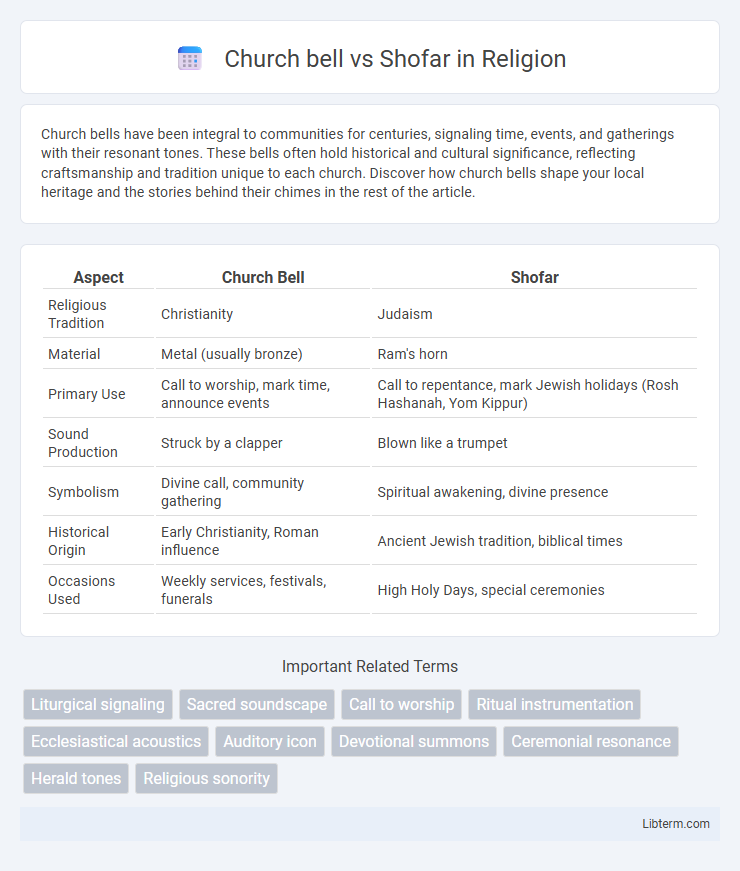Church bells have been integral to communities for centuries, signaling time, events, and gatherings with their resonant tones. These bells often hold historical and cultural significance, reflecting craftsmanship and tradition unique to each church. Discover how church bells shape your local heritage and the stories behind their chimes in the rest of the article.
Table of Comparison
| Aspect | Church Bell | Shofar |
|---|---|---|
| Religious Tradition | Christianity | Judaism |
| Material | Metal (usually bronze) | Ram's horn |
| Primary Use | Call to worship, mark time, announce events | Call to repentance, mark Jewish holidays (Rosh Hashanah, Yom Kippur) |
| Sound Production | Struck by a clapper | Blown like a trumpet |
| Symbolism | Divine call, community gathering | Spiritual awakening, divine presence |
| Historical Origin | Early Christianity, Roman influence | Ancient Jewish tradition, biblical times |
| Occasions Used | Weekly services, festivals, funerals | High Holy Days, special ceremonies |
Historical Origins of the Church Bell and Shofar
The church bell, originating in early medieval Europe around the 5th century, was primarily used to signal worship times and community events, evolving from ancient bronze ringing instruments. The shofar, an ancient Jewish ritual horn made from a ram's horn, dates back to biblical times and serves as a call to repentance and spiritual awakening in religious ceremonies. While the church bell symbolizes Christian communal worship, the shofar embodies Jewish religious tradition and prophetic significance.
Religious Symbolism and Meaning
Church bells symbolize the Christian call to worship, marking sacred time and signaling important liturgical events, embodying communal faith and divine presence. The shofar, an ancient ram's horn used in Jewish worship, represents a spiritual awakening, repentance, and the heralding of significant religious occasions like Rosh Hashanah and Yom Kippur. Both instruments serve as potent auditory symbols, evoking deep spiritual reflection and connection within their respective faith traditions.
Materials and Craftsmanship
Church bells are typically crafted from bronze, an alloy of copper and tin, using a precise casting process that ensures durability and a resonant tone. Shofars, made from the horn of a ram or other kosher animals, require intricate hand-carving and polishing to create a functional and sacred musical instrument. The craftsmanship of church bells emphasizes metallurgical expertise and acoustic precision, while shofar making relies on traditional techniques and religious rituals to preserve its spiritual significance.
Roles in Worship and Rituals
Church bells serve as auditory signals in Christian worship, marking prayer times, calling congregants to services, and celebrating significant liturgical events. The shofar, a ram's horn, holds profound ritual significance in Judaism, especially during Rosh Hashanah and Yom Kippur, symbolizing spiritual awakening and divine revelation. Both instruments function as sacred sound devices that enhance communal worship and reinforce religious traditions through their distinct tonal symbolism.
Sound Characteristics and Acoustic Differences
Church bells produce a resonant, rich, and sonorous tone with sustained vibrations and harmonic overtones shaped by their large metal structure, creating a deep and harmonious sound that carries over long distances. Shofars emit a raw, brassy, and piercing sound marked by sharp tonal fluctuations and limited harmonic complexity, generated by the natural horn's irregular shape and material, resulting in a more primal and direct acoustic effect. The acoustic differences stem from material composition, with bells made of bronze alloy enhancing sustained resonance while shofars, carved from ram's horn, focus sound through a narrow mouthpiece producing a brassy and urgent timbre.
Cultural Significance in Community Life
Church bells symbolize communal unity and spiritual awakening in Christian traditions, marking time, calling worshippers, and signaling important events. The shofar holds profound cultural and religious significance in Jewish life, used during Rosh Hashanah and Yom Kippur to inspire reflection, repentance, and renewal. Both instruments serve as auditory icons that strengthen group identity and reinforce shared values within their respective communities.
Usage in Ceremonies and Festivals
Church bells are traditionally used in Christian ceremonies and festivals to signal the start of worship, call congregants to prayer, and mark significant liturgical events such as weddings and funerals. The shofar, a ram's horn, holds a central role in Jewish religious ceremonies, particularly during Rosh Hashanah and Yom Kippur, where its blasts symbolize spiritual awakening and repentance. While church bells produce melodious sounds to unify communities, the shofar's distinctive blasts serve as a solemn call to reflection and divine connection.
Evolution Through the Ages
The church bell originated in early medieval Europe as a tool for calling congregants to worship and evolved with advancements in metallurgy and casting techniques, reflecting Christian liturgical traditions. The shofar, an ancient horn made from a ram's horn, dates back to biblical times and has remained largely unchanged, symbolizing Jewish religious ceremonies and significant historical events. Both instruments demonstrate the cultural and technological shifts in their respective societies while maintaining distinct spiritual purposes through the centuries.
Regional Variations and Practices
Church bells are predominantly used in Christian worship across Europe and the Americas, signaling time for prayer, marking ceremonies, and calling congregations, with distinct tonal patterns varying regionally, such as the peal style in England or the carillon in Belgium. The shofar, a ram's horn, holds significant ritual importance in Jewish tradition, primarily during Rosh Hashanah and Yom Kippur, with variations in its blowing techniques observed between Sephardic and Ashkenazi communities. Both instruments embody regional liturgical customs, reflecting localized religious rhythms and historical developments within their respective faiths.
Modern-Day Relevance and Adaptation
Church bells remain integral to Christian worship and community life, signaling time for prayer and marking significant events in modern society. The shofar continues to hold profound religious importance in Judaism, especially during Rosh Hashanah and Yom Kippur, symbolizing spiritual awakening and reflection. Both instruments adapt through technological integration in urban settings, preserving their sacred use while reaching broader audiences via digital broadcasts.
Church bell Infographic

 libterm.com
libterm.com